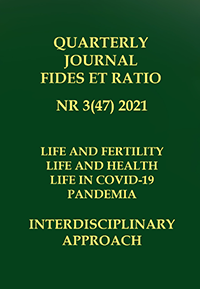Abstract
The aim of the study was to verify the level of burnout severity in nursing staff working in various health care sectors that were not dedicated to providing health services to people with COVID-19 infection. The relationship between the level of empathy, altruism and depression and the intensity of individual burnout indicators was also analyzed. professional among the respondents.
The study covered a total of 178 people - staff employed in psychiatric care (64 people) and in other health care sectors (114 people). The study participants completed five questionnaires: a sociodemographic and four clinical tests: Christina Maslach's Burnout Questionnaire, Beck Depression Scale, Balanced Emotional Empathy Scale, and Altruistic Attitudes Questionnaire. Using clinical tests, the following were assessed: the general index of occupational burnout and its three dimensions (emotional exhaustion, depersonalization and job satisfaction), the level of depression, altruism and emotional empathy. Nursing staff employed in psychiatric care was characterized by lower levels of emotional exhaustion and depersonalization, as well as professional satisfaction and altruism compared to the average medical staff employed in health care sectors other than psychiatric. Moreover, a positive correlation was found between the severity of depression and the level of emotional exhaustion, depersonalization and general occupational burnout index in both study groups (psychiatric versus non-psychiatric nursing staff). Nursing staff representatives working in psychiatric health care units are characterized by a lower level of occupational burnout, altruism and job satisfaction than in the case of people employed in other medical sectors. A higher level of occupational burnout is associated with a greater intensity of depressive symptoms. Differences in the levels of individual dimensions of occupational burnout and altruism may result from the specificity of work in various medical sectors. It should be emphasized that the chronicity, recurrence of mental illnesses, the higher rate of rehospitalisation of patients with mental disorders or the delayed effect of the therapeutic process.
References
Arora, M., Diwan, A., Harris, I. (2013). Burnout in orthopaedic surgeons: a review, ANZ Journal of Surgery, 83 (7-8), 512-525, https://doi.org/10.1111/ans.12292.
Bakker, A., & Costa, P. (2014). Chronic job burnout and daily functioning: A theoretical analysis, Burnout Research, 1 (3), 112-119, https://doi.org/10.1016/j.burn.2014.04.003.
Beck, A., Ward, C., Mendelson, M., Mock, J., & Erbaugh, J. (1961). An Inventory for Measuring Depression, Archives of General Psychiatry, 4 (6), 561-571, https://doi.org/10.1001/archpsyc.1961.01710120031004.
Chen, R., Sun, C., Chen, J., Jen, H., Kang, X., Kao, C., & Chou, K. (2021). A Large-Scale Survey on Trauma, Burnout, and Posttraumatic Growth among Nurses during the COVID-19 Pandemic, International Journal of Mental Health Nursing, 30 (1), https://doi.org/10.1111/inm.12796.
Dimou, F., Eckelbarger, D., & Riall, T. (2016). Surgeon Burnout: A Systematic Review, Journal of the American College of Surgeons, 222 (6), https://doi.org/10.1016/j.jamcollsurg.2016.03.022.
Fengler, J. (2000). Pomaganie męczy. Wypalenie w pracy zawodowej, Gdańsk: Gdańskie Wydawnictwo Psychologiczne.
Hakanen, J., & Bakker, A. (2017). Born and bred to burn out: A life-course view and reflections on job burnout, Journal of Occupational Health Psychology, 22 (3), https://doi.org/10.1037/ocp0000053.
Hemming, L., Haddock, G., Shaw, J., Pratt, D. (2019). Alexithymia and Its Associations With Depression, Suicidality, and Aggression: An Overview of the Literature, Frontiers in Psychiatry, 11 (10), 203, https://doi.org/10.3389/fpsyt.2019.00203.
Huynh, Ch., Bowles, D., Yen, M., Phillips, A., Waller, R., Hall, L., Tu, S. (2018). Change implementation: the association of adaptive reserve and burnout among inpatient medicine physicians and nurses, Journal of Interprofessional Care, 32 (5), 549-555, https://doi.org/10.1080/13561820.2018.1451307.
Maslach, C. (2003). Job Burnout: New Directions in Research and Intervention, Current Directions in Psychological Science, 12, 189-192, https://doi.org/10.1111/1467-8721.01258.
Maslach, C., Jackson, S., & Leiter, M. (1996). Maslach Burnout Inventory, Palo Alto: Consulting Psychologists Press.
Maslach, C., Schaufeli, W., & Leiter, M. (2001). Job burnout. Annual Review of Psychology, 52, https://doi.org/10.1146/annurev.psych.52.1.397.
McCarthy, J., Gastmans, Ch. (2015). Moral distress: a review of the argument-based nursing ethics literaturę, Nursing Ethics, 22 (1), 131-52, https://doi.org/10.1177/0969733014557139.
Mehrabian, A. (1997). Analysis of affiliation-related traits in terms of the PAD Temperament Model, The Journal of Psychology, 131 (1), https://doi.org/10.1080/00223989709603508.
Molina-Praena, J., Ramirez-Baena, L., Gómez-Urquiza, J., Cañadas, G., De la Fuente, E., & Cañadas-De la Fuente, G. (2018). Levels of Burnout and Risk Factors in Medical Area Nurses: A Meta-Analytic Study, International Journal of Environmental Research and Public Health, 15 (12), https://doi.org/10.3390/ijerph15122800.
Naczenski, L., de Vries, J., van Hooff, M., Kompier, M. (2017). Systematic review of the association between physical activity and burnout, Journal of Occupational Health, 25, (6), 477-494, https://doi.org/10.1539/joh.17-0050-RA.
Pasikowski, T. (2009). Polska adaptacja kwestionariusza Maslach Burnout Inventory, Warszawa.
Rushton, J., Chrisjohn, R., & Fekken, C. (1981). The altruistic personality and the self-report altruizm scale, Personality and Individual Differences, 2 (4), 293-302, https://doi.org/10.1016/0191-8869(81)90084-2.
Szach, P. (2014). Relacja lekarz-pacjent czyli o podejściu egzystencjalnym w przebiegu chorób o charakterze psychosomatycznym, Sztuka Leczenia, 3 (4), 71-80.
Trockel, M., Sinsky, Ch., West, C., Dyrbye, L., Tutty, M., Carlasare, L., Wang, H., Shanafelt, T. (2021). Self-valuation Challenges in the Culture and Practice of Medicine and Physician Well-being, Mayo Clinic Proceedings, 10 (21), 51-53, https://doi.org/10.1016/j.mayocp.2020.12.032.
Verret, C., Nguyen, J., Verret, C., Albert, T., Fufa, D. (2021). How Do Areas of Work Life Drive Burnout in Orthopaedic Attending Surgeons, Fellows, and Residents? Clinal Orthopedics and Related Research, 1, 479 (2), 251-262, https://doi.org/10.1097/CORR.0000000000001457.
Wei, H., Roberts, P., Strickler, J., Corbett, R. (2019). Nurse leaders’ strategies to foster nurse resilience, Journal of Nursing Management, 27 (4), 681-687, https://doi.org/10.1111/jonm.12736.
White, E., Aiken, L., McHugh, M. (2019). Registered Nurse Burnout, Job Dissatisfaction, and Missed Care in Nursing Homes, Journal of American Geriatrics Society, 67 (10), 2065- 2071, https://doi.org/10.1111/jgs.16051.
Wilkinson, H., Whittington, R., Perry, L., & Eames, C. (2017). Examining the relationship between burnout and empathy in healthcare professionals: A systematic review, Burnout research, 6, https://doi.org/10.1016/j.burn.2017.06.003.
Yu, F., Raphael, D., Mackay, L., Smith, M., King, A. (2019). Personal and work-related factors associated with nurse resilience: A systematic review, International Journal of Nursing Studies, 93, 129-140, https://doi.org/10.1016/j.ijnurstu.2019.02.014.
Zimmerman, R., Swider, B., Eun Woo, S., Allen, G. (2016). Who withdraws? Psychological individual differences and employee withdrawal behaviors, Journal of Applied Psychology, 1014, 498-519, https://doi.org/10.1037/apl0000068.

